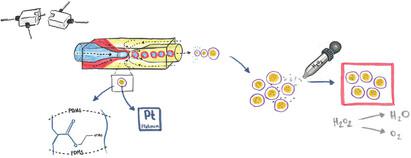当前位置:
X-MOL 学术
›
Adv. Mater. Technol.
›
论文详情
Our official English website, www.x-mol.net, welcomes your feedback! (Note: you will need to create a separate account there.)
Microfluidically Produced Microcapsules with Amphiphilic Polymer Conetwork Shells
Advanced Materials Technologies ( IF 6.8 ) Pub Date : 2024-04-09 , DOI: 10.1002/admt.202400109 Sara T. R. Velasquez 1, 2, 3 , Andrea Belluati 1, 2 , Elena Tervoort 4 , Iacopo Mattich 4 , Brigitte Hertel 5 , Sam Russell 1, 2, 3 , Micael G. Gouveia 2, 3 , Patrick Grysan 6 , Clément Mugemana 6, 7 , André R. Studart 3, 4 , Nico Bruns 1, 2, 3
Advanced Materials Technologies ( IF 6.8 ) Pub Date : 2024-04-09 , DOI: 10.1002/admt.202400109 Sara T. R. Velasquez 1, 2, 3 , Andrea Belluati 1, 2 , Elena Tervoort 4 , Iacopo Mattich 4 , Brigitte Hertel 5 , Sam Russell 1, 2, 3 , Micael G. Gouveia 2, 3 , Patrick Grysan 6 , Clément Mugemana 6, 7 , André R. Studart 3, 4 , Nico Bruns 1, 2, 3
Affiliation

|
Microcapsules with an aqueous core can be conveniently prepared by water‐in‐oil‐in‐water double emulsion microfluidics. However, conventional shell materials are based on hydrophobic polymers or colloidal particles. Thus, these microcapsules feature a hydrophobic shell impermeable to water‐soluble compounds. Capsules with semipermeable hydrogel shells have been demonstrated but may exhibit poor mechanical properties. Here, amphiphilic polymer conetworks (APCNs) based on poly(2‐hydroxyethyl acrylate)‐linked by ‐polydimethylsiloxane (PHEA‐l ‐PDMS) are introduced as a new class of wall materials in double emulsion microcapsules. These APCNs are mechanically robust silicone hydrogels that are swellable and permeable to water and are soft and elastic when dry or swollen. Therefore, the microcapsules can be dried and rehydrated multiple times or shrunken in sodium chloride salt solutions without getting damaged. Moreover, the APCNs are permeable for hydrophilic organic compounds and impermeable for macromolecules. Thus, they can be loaded with macromolecules or nanoparticles during microfluidic formation and with organic molecules after capsule synthesis. The microcapsules serve as microreactors for catalytically active platinum nanoparticles that decompose hydrogen peroxide. Finally, the surface of the APCN microcapsules can be selectively functionalized with a cholesterol‐based linker. Concluding, APCN microcapsules could find applications for the controlled delivery of drugs, as microreactors for synthesis, or as scaffolds for synthetic cells.
中文翻译:

具有两亲性聚合物共网络壳的微流控微胶囊
具有水核的微胶囊可以通过水包油包水双乳液微流体方便地制备。然而,传统的壳材料基于疏水性聚合物或胶体颗粒。因此,这些微胶囊具有疏水性外壳,水溶性化合物无法渗透。具有半渗透性水凝胶壳的胶囊已被证实,但可能表现出较差的机械性能。这里,基于聚(丙烯酸2-羟乙酯)的两亲性聚合物共网络(APCN)-链接于 ‐聚二甲基硅氧烷(PHEA‐我 ‐PDMS)作为双乳液微胶囊中的新型壁材料被引入。这些 APCN 是机械坚固的硅水凝胶,可膨胀且可透水,并且在干燥或膨胀时柔软且有弹性。因此,微胶囊可以多次干燥和再水化或在氯化钠盐溶液中收缩而不会损坏。此外,APCN对亲水性有机化合物是可渗透的,但对大分子是不可渗透的。因此,它们可以在微流体形成过程中装载大分子或纳米颗粒,并在胶囊合成后装载有机分子。微胶囊充当催化活性铂纳米颗粒的微反应器,可分解过氧化氢。最后,APCN 微胶囊的表面可以用基于胆固醇的连接体选择性地功能化。总之,APCN 微胶囊可以应用于药物的控制递送,作为合成的微反应器,或作为合成细胞的支架。
更新日期:2024-04-09
中文翻译:

具有两亲性聚合物共网络壳的微流控微胶囊
具有水核的微胶囊可以通过水包油包水双乳液微流体方便地制备。然而,传统的壳材料基于疏水性聚合物或胶体颗粒。因此,这些微胶囊具有疏水性外壳,水溶性化合物无法渗透。具有半渗透性水凝胶壳的胶囊已被证实,但可能表现出较差的机械性能。这里,基于聚(丙烯酸2-羟乙酯)的两亲性聚合物共网络(APCN)-



























 京公网安备 11010802027423号
京公网安备 11010802027423号